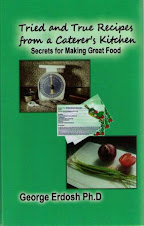Cilantro

Thursday, October 15, 2015
PAN-ROASTED PAPRIKA-ONION POTATOES
One of my favorite ways with potatoes takes three cooking
stages and three ingredients—it’s not quick but it’s worth the time spent.
The ingredients are potatoes, onion and paprika and a bit
of oil for pan-roasting roast.
I take a pound of russets, peel and dice them into fairly
large irregular chunks, size of walnuts. I cook them in salted boiling water
for about nine minutes until they are partially cooked but still slightly firm.
I drain the pot and set the potatoes aside.
I chop about half a cup (2 oz) of onion and sauté them
gently in a teaspoon of vegetable oil until just beginning to soften, about
five minutes, and add 2 teaspoons of paprika (it may be smoked paprika). Stir
the paprika into the onion and let gently cook for half a minute so stirring constantly
so the paprika slightly caramelizes.
I remove the onion from the pan and set aside and wipe
the pan clean.
Adding a teaspoon of vegetable oil to the same pan I heat
it until fairly hot and add the potatoes with half teaspoon salt to gently pan-roast
for about 35 minutes, stirring often until the potatoes are browning. You may need
to roast them longer until browned to your taste, and may add a little more oil
as needed.
Just before serving I add the onion to the potatoes, stir
well and continue heating for a few minutes. You have a wonderful side dish
serving four.
Monday, October 12, 2015
SALT BLOCK COOKING
As a professional book reviewer, some strange ones come my
way.
I just reviewed one on salt block cooking. I never even knew
such a thing exists. But it does and there are some half dozen sources sell
them anywhere from $30 to $50 a block that measures 12x8x1½ inches (and many
other sizes are available). These blocks come from a pink salt deposit in the Himalayan
Mountains of Pakistan.
Cooking and baking with salt block is arduous and time
consuming. You need to heat the block slowly on stove top then measuring its
temperature by a laser thermometer. In 30 minutes it should be preheated and
you can either cook on it or place it in the oven to bake on it—like you would on
a pizza stone.
The authors of that cookbook claim that everything tastes
better using salt block cooking—but I remain unconvinced. Why would it?
Heating the block takes too long. To prepare a fried egg
in a hole will costs you 35 minutes. On the stove top it takes 4 to 5 minutes. You
also need to be careful that the food is not too moist or the salt black it hot
enough in which cases the food absorbs salt from the block and your product is
oversalted.
If you ever used a salt block for cooking and baking
please let me know what you think of it.
Monday, October 5, 2015
HORNO
A Spanish word for oven, horno was built by Native Americans
from clay adobo to cook their meals. Now several centuries later hornos are
trendy again and you find many plans and building advice online to build your
own. I have a number of friends who built their own with modest success.
One friend built it too small. I was invited to dinner
when the horno was still fairly new and I took a nearly fully risen bread dough
that I’d hoped to bake in his horno. A small horno has two problems. Once it
has been heated up it loses its heat too fast. Second, it has a limited
capacity.
At this party I placed my bread dough in the preheated hot
horno (about 450 degrees) and for a while a looked as it’s going to bake just
right. But the horno cooled too much. When my bread was more or less done, the
host added more fuel and placed a marinated chicken in the hot horno. Alas,
after some 30 minutes the chicken was brown but the inside nearly raw. By now
the guests were well passed ready to eat besides the hors d’oeuvres. The host lifted
the chicken out of the horno and, to our horror, finished cooking it in a
microwave. The results were mediocre to poor.
Another friend built his horno very elaborate and huge;
so big a small piglet would’ve fit inside. It had all kinds of bells and whistles
and looked very impressive. But it also had problems. It took many hours of burning
oak logs before it heated up to useable temperatures. So when you don’t know
how long, how are you going to manipulate your ready bread dough or pizza dough
before it’s over-proofed? You cannot. The friend used this horno only once or
twice than given up. Now it’s an outdoor decoration.
A third friend also built one that he claims is perfect
but I yet to see it in use.
Hornos are very tricky, fun when they work but somehow I
prefer to rely on my well-regulated oven.
Subscribe to:
Comments (Atom)





 Stumble It!
Stumble It!










